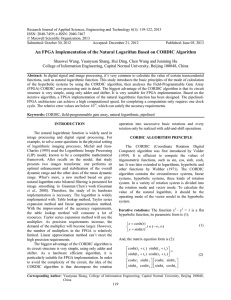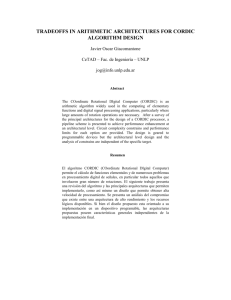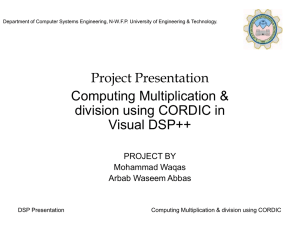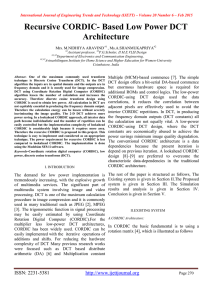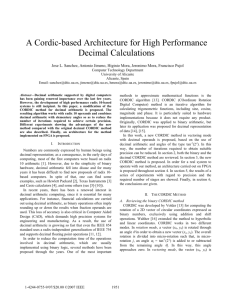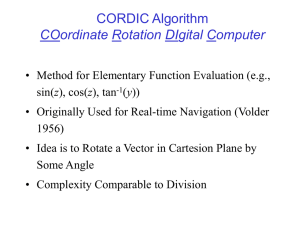A
advertisement
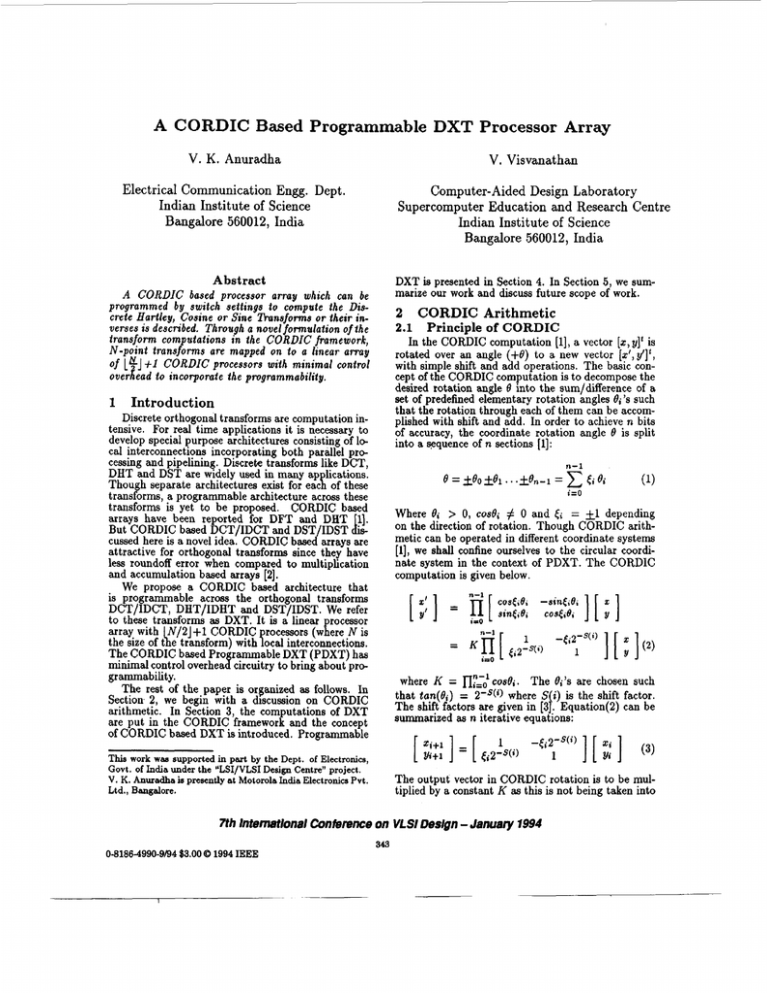
A CORDIC Based Programmable DXT Processor Array V. K. Anuradha V. Visvanathan Electrical Communication Engg. Dept. Indian Institute of Science Bangalore 560012, India Computer-Aided Design Laboratory Supercomputer Education and Research Centre Indian Institute of Science Bangalore 560012, India Abstract DXT is presented in Section 4. In Section 5 , we summarize our work and discuss future scope of work. A CORDIC based processor array which can be programmed by switch settings to compute the Discrete Hariley, Cosine or Sine lhnsforms or their inverses i s described. Through a novel formulation of the transform computations in the CORDIC framework, N-point transforms are mapped on to a linear a m y of [XJ+1 CORDIC processors with minimal control owedead to incorporate the programmability. 1 2 CORDIC Arithmetic 2.1 Principle of CORDIC In the CORDIC computation [l],a vector [z, 91' is rotated over an angle (+e) to a new vector [z',y'It, with simple shift and add operations. The basic concept of the CORDIC computation is to decompose the desired rotation angle 0 into the sum/difference of a set of predefined elementary rotation angles ej's such that the rotation through each of them can be accomplished with shift and add. In order to achieve n bits of accuracy, the coordinate rotation angle 0 is split into a sequence of n sections [l]: Introduction Discrete orthogonal transforms are computation intensive. For real time applications it is necessary to develop special purpose architectures consisting of local interconnections incorporating both parallel processing and pipelining. Discrete transforms like DCT, DHT and DST are widely used in many ap lications. Though separate architectures exist for eac! of these transforms, a programmable architecture across these transforms is yet to be proposed. CORDIC based arrays have been reported for DFT and DHT 11 But CORDIC based DCT/IDCT and DST/IDST di, cussed here is a novel idea. CORDIC based arrays are attractive for orthogonal transforms since they have less roundoff error when compared to multiplication and accumulation based arrays [2]. We propose a CORDIC based architecture that is programmable across the orthogonal transforms DCT/IDCT, DHT/IDHT and DST/IDST. We refer to these transforms as DXT. It is a linear processor array with N/2J+1 CORDIC rocessors (where N is the size of t e transform) with focal interconnections. The CORDIC based Pro rammable DXT (PDXT) has minimal control overheaf circuitry to bring about programmability. The rest of the paper is organized as follows. In Section 2, we begin with a &scussion on CORDIC arithmetic. In Section 3, the com utations of DXT are put in the CORDIC framewor! and the concept of CORDIC based DXT is introduced. Programmable n-1 e = feokel.. tjei = (1) i=O = f l depending Where 0, > 0, cos& # 0 and on the direction of rotation. Though CORDIC arithmetic can be operated in different coordinate systems [l], we shall confine ourselves to the circular coordinate system in the context of PDXT. The CORDIC computation is given below. n-1 c03€~0, -sin€,& sin(s6i COS(r6t h where K = cost', . The &'s are chosen such that tan(&) = 2's(i) where S i) is the shift factor. The shift factors are given in [3f. Equation(2) can be summarized as n iterative equations: This work was supported in part by the Dept. of Electronics, Govt. of India under the "LSI/VLSI Design Centre" project. V. K. Anuradha is presently at Motorola India Electronics Pvt. The output vector in CORDIC rotation is to be multiplied by a constant K as this is not being taken into Ltd., Bangalore. 7th lntemlonal Conferenceon VLSI Design - January 1994 343 0-8186-4990-9/94 $3.00 (9 1994 IEEE results in the reduction of the number of CORDIC processors required by 50%. Diswete Hartley transform: The Discrete Hartley N-point transform given by H ( r ) is defined [5] as follows: c N- 1 X(r) = z(k)[C(f, k) + S(r,k)l (4) k=O r = 0 , 1 , ...,N - 1 . H ( r ) = (1/”.) I Here, C ( r , k ) = cos(2srk/N) and S ( r , k ) = sin(2xrk/N). From now onward, we work with X ( r ) only. The multiplicative constant (l/N) can be subsumed with the CORDIC post multiplicative constant K. Equation(4) can be written as follows: I zit1 Yitl s : shifter N-1 Figure 1: CORDIC Micra-rotation Module (CMM) . t X(N - r ) = N-1 C z(k)[cos(2s(~- r ) k / N ) k=O +sin(Sn(N N-1 = - r)k/N)] z(k) [C(Ck) - S ( f ,k)] (6) (7) k=O r = 0,1,. . .,N d -1 Then, we can write the expression for DHT as follows: where r = 0, 1, .. .,N/2. Comparing eq(5) with eq(8) we can observe that two transform pomts are computed by each macro-rotation. This results in a 100% gain in the utilization of the CORDIC computation when compared to the implementation in [5]. Inverse Discrete Hartley Transform:IDHT is defined as 3 CORDIC Based DXT In this section we rewrite the computations of each of the DXTs such that they can be mapped efficiently onto a CORDIC processor array. Later a unified CORDIC processor array is derived which can be programmed to obtain any one of the DXTs. N-1 + H(r) [W, k) S(r,,)I Z(k) = 3.1 CORDIC Based DHT/IDHT CORDIC based solution for DHT has been proposed in [5]. In this section we improve upon this and increase the CORDIC processor utilization. This (9) r=O . Here, k = 0, 1, . .,N - 1 Except for the multiplicative constant (l/N), the expression for IDHT is same as 344 I - r = 0, 1, . .,N 1. Chang and Lee [5] have mapped this computation on to a linear processor array using N CORDIC processin elements. We can see from the above that the CO#,DIC computation is not being used efficiently. We propose the following rearrangement to improve the efficiency. Consider the following: account in eq(3). Various techniques have been proposed to reduce this computation overhead [l]. The symmetr properties of transform kernels of the DXT are e x p h e d to implement DXT efficiently in the CORDIC framework. Given the transform size N of DXT, correspondin rotation angles 8’s are known. We can therefore evafuate the corresponding unique t i ’ s that satisfy e (1). Only (j’s are going to vary across the DXT. Tley can be stored in the CORDIC module to realize the transform of interest, which is com uted by the iterative equations 3 This forms the iasic principle of Programmable 6dT. 2.2 CORDIC Architectures We can describe the CORDIC iterations as a sequence of micro-rotation operations 41 where the computation described by eq(3 is calle a micmrotation. CORDIC Micro-rotation odule (CMM) is shown in Figure 1. One macro-rotation requires n microrotations where a macro-rotation is the computation of eq(2) excluding the multiplicative constant K. The t i ’ s corresponding to the rotation angle 0 and the shift factors are stored in the CMM. If the clock period (Telock) is matched to the time taken for each micro-rotation then the total time taken for a macrorotation (T,,,,.,)= n Tclock. the DHT, hence the same algebra holds. Therefore, eq(9) can be written as follows: [ as a pre-multiplication, hence it has to be dealt with separately. This is taken care of in the CORDIC based IDCT by absorbing it as a CORDIC macro-rotation. The symmetry between z(k) and z ( N - k - 1) is used to express the computation of IDCT in the CORDIC form effectively. ]= z(?k) z(N - k - 1) = E + l)r/2N) c(r)(-l)'G(r)cos(r(2k 3.2 CORDIC Based DCT/IDCT So far man VLSI implementations of DCT have been reportedr using techniques other than CORDIC arithmetic. In this section we rearrange the DCT IDCT computation to be able to realize it efficient y using CORDIC macro-rotation operation. Discrete Cosine Transform: The N-point DCT given by G(r) is defined [6] as follows: Since rotation by 4 5 O corresponds to multiplication by we can write eq(15) and eq(16) as &, i [ ]=[ cos(45') -sin(4S0) sin(45O) cos(45O) = C z(k)cos(+(~k+ l ) r / 2 ~ ) k=O r =O,l, + ] G ~ I (17) (11) ...,N - 1 = c(r)X(r) G(r) 3 [ Gr)] ][ N-1 N-1 X(r) (16) r=O (12) c(r)=l/fi for r=O and c(r)=l otherwise. We exploit the symmetry property of X ( r ) and X(N -r) to be able to use the CORDIC unit effectively for DCT computation. X(N - r) = N-1 z(k) cos(x(2k + I)(N - r ) / 2 ~ ) k=O N-1 = + l)r/2N) z(k)(-l)'s:n(r(2k As can be observed from the above two equations, it is enou h to compute z(k) for k = 0, 1, . . .,(N/2 - 1). z(N - 1) can be computed from that. After rotating the vector [G r),OIt by an angle 2k l)rr/2N we accumulate t e result over r = , 1,. . ,N - 1 to obtain the correspondin z(k). After each rotation the result is either adc fed or subtracted dependin on whether r is even or odd to obtain z ( -~k - 17, -& (13) k=O 6 From eq(l1) and eq(13) we can write the following: N-1 C'(r, k) + Here, r = 0,1, ..., N/2. C'(r,k) = cos(r(2k l)r/2N) and S'(r,k) = sin(r(2k l)r/2N). Note that for alternate k, the data vector [ z ( k ,O]$ is rotated either bym(2k 1)17r/2N or -(2k )rr/2N. Inverse Discrete Cosine Transform: The IDCT is defined [6] as follows: + c(r) G(r)cos(r(2k r=O k = 0, 1,. ..,N +2 N x(r) = C z(k)sin(+kr/N + 1) (19) ksl r = 1, ...,N N-1 z(k) = 6 . 3.3 CORDIC Based DST/IDST The technique of rearranging the computation to obtain CORDIC based IDCT can be easily extended to DST/IDST. Discrete Sine Transform: The N-point discrete sine transform given by G(r)is defined [SI as follows: (-l)k+lS'(r, k) + + + l)r/2N) G(r) = c(r)X(r) (15) d m . (20) c(r) = Note that for DST indexes are defined from 1to N instead of 0 to N 1. In DST, the relationship between X ( r ) and X(N 1 - r ) is used - 1. c(r) = l/& if r = 0 and c(r) = 1 - + otherwise. Unlike the DCT, in IDCT, c(r) manifests 345 to rewrite the computation to put it in the CORDIC framework as follows. D I CPEO D 1 Drdclrg for r = lj. .,N/2. Here, C" r,k) = cos(rkr/N 1) and SN(r,k) = sin(.nkr/ + 1). From eq(21) and eq(22) we can conclude that, it is sufficient to evaluate X(r) for r = l J 2 ,...,N/2. X ( N + l - r ) can be com uted from this by appropriately adding/subtractin tge r e sulting macro-rotation depending on whether\ is odd or even. Inverse Discrete Sine Transform: IDST given by z'(k) is defined [SI as Figure 2: CORDIC Based Systolic Array for DCT + N z(k) = G(r)sin(.nkr/N + 1) (23) r=l z w = ( m ) z o ) It has the same form as DST. Hence the algebra d e veloped for DST is applicable for IDST also. The expression for CORDIC based IDST is given below. 4 Programmable DXT In this section we derive the s stolic processor array for DCT based on eq(14), andrfor IDCT based on eq(17) and eq(18). Note that an efficient CORDIC based architecture for DCT or IDCT has not been reported 80 far. CORDIC based systolic arrays for the other DXTs are also derived similarly. The concept of Programmable DXT (PDXT) is introduced based on this. 4.1 DCT Array Following a straight forward application of the canonical mapping methodology discussed in [8], the computation of eq(14) is mapped on to the systolic processor array shown in Figure 2. We call the basic computational module, CORDIC Processing Element (CPE Each CPE is responsible for computin X(r) and k ( N - r). The CPE consists of a C M h and two accumulators Accl & Acc2. After each macrorotation, the result is accumulated in Accl and Acc2. After the N'h macro-rotation Accl and Acc2 contain X(r) and X(N-r) respectively. For an N-point transform we need to compute X(O),X(l), . , X N - 1). Depending on whether N is even or odd we ave the following two cases. For N even: With N/2 1 CPEs we obtain all the transform points. k(0) and X(N) are available from the Oth CPE. But X(N) is not required. We get X(N/2) at both the out uts of the (N/2)thCPE. Any one of them can be u s e 1 For N odd: Here there will be ([N/2J 1) CPEs. X(0) and X(N)are available from the O'h CPE. X(N) is not required. But both the outputs of the ( [N/2J)'h CPE are used. Combininn both odd and even cases. we can sav that, there wyll in general be ([N/2 1) CPEs in thk CORDIC based systolic array for CT. Each processor-computesX(r) and X ( N - r). The output won't be in the sequential order if we take them out using a single link. So two serial links are used for this purpose. The interconnection between the neigh- .. 6 + + for k = l ,..., N / 2 . In this section we have rearran ed the computation of each of the DXTs to fit it in thetORDIC framework efficiently. From eq(S), eq 10) e (14), eq(17), eq(18), eq(22), eq(24), an6 eq(25j we can see that the IC macro-rotation is the basic commtation in all of them. Thia paves way for a unified CORDIC based DXT. d+ D .. .. I S1 bi band Sa bt b lor N even. S1 bt b bnd Sa bt b lor N odd. CPEO 1 (b) I N CPEN/2-l I CVCE+ Figure 3: Output phase for DCT boring processors in the out ut phase is depicted in Figure 3 for N even and o l d casea. Note that the output phase takes N clock cycles. be matched to the Let the basic clock cycle (TctOck) time taken for one micro-rotation in a CPE. TCl,,pm Todd T'hijt where Todd = time taken for addition; T'hijt = time taken for shifting. Having two additional registers per CPE, the output phase can be overlapped with the computation phase. With this Latenc is (Nn IN/2J N)Tclock and throughput is l/(nNfTcrock. + + U CPE LN/2J (b) N odd. + Figure 4: CORDIC Based Systolic Array for IDCT for (a)N even (b)N odd 4.2 IDCT Array From eq(17) and eq(18), using the same mapping methodolo y, we can obtain the systolic processor array for ID8T (Figure 4 Here the vector G(r) 0 t is rotated by an angle (2 + l)rr/2N and t e resu t is accumulated over r = 0, 1,. . . ,N 1 in Ace1 to obtain x(k). Acc2, on the other hand, takes the same input as Accl and alternately adds it to or subtracts it from the accumulated value (depending on whether r is even or odd) in order to obtain z ( N - k - 1 . Depending on N being even or odd we have the fol owing two cases. For N even: We need (N 2) processors to com Ute all the transform points. A 1 the outputs from alfthe CPEs are used 1 CPEs are used (Fi ure both the outputs ofthe (IN/2] + 1)'" CPE. Any one of them can be used. ). - 4.4 The PDXT We observed that the DXTs can be mapped on to a CORDIC linear systolic array with minimal variation across the transforms. Those variations that remain, and the appropriate control circuitry, which is to be programmed to realize any one of the DXTs is given below. h r' e The e's, and hence the ti's are going to vary across the DXTs. Since the 0's are known, the corresponding ti's are evaluated off line and stored in the CMM. e The interconnection of the registers containing the transform values in the output phase is going to be different for the DXTs., This is taken care of, by providing switches which can be programmed. e The accumulator Accl will add and accumulate the result of the macro-rotations. Acc2 differs from this slightly a8 it has to either be a straight forward adder for some DXTs (DHT, IDHT and DCT), or alternately add or subtract for other DXTs (IDCT, DST and IDST). This can be brought forth by having a flip-flop to control this functioning. i DHT, IDHT, DST and IDST Arrays Comparing eq(14 and eq(8) we can observe that, the DHT array will I! e similar to the DCT array (Figure 2). Here, ti's corresponding to 2akr/N have to be ro rammed in the CPE. At the input we have [z&,z/iJ' instead of [z(i),O]' as is the case in DCT. C D based IDHT is simlar to DHT/DCT array. Equation(21) and Equation(22) are used to derive the systolic array for DST. By noting the similarity of these equations with e (17) and e (18) we can conclude that, the CORDIC$ased syst&c array for DST will resemble the IDCT array. The ti's correspond to rkr/N 1. In ut vector for the CPE is [0, z(k)]'. IDST will be simiyar to the DST/IDCT array. 4.3 With this, the concept of PDXT is substantiated and the final PDXT along with the switches required for the rogrammability IS shown in Figure 5. Depending on tge position of these switches, the DXT of interest + 347 5 Summary & Future work In sum, we have rearranged the computations of the Discrete Hartley, Cosine and Sine Transforms and their inverses to be able to realize each of them using CORDIC arithmetic efficiently. We refer to these transforms as DXT. We derived the CORDIC based systolic processor arrays for the DXTs. For an N point DXT, we need a maximum of ([$J 1) CORDIC processors to implement any of the DXTs. Based on this we introduced the concept of pro ammable DXT. With minimal control circuitry, a (1 J 1) CORDIC processor array can be used to implement any of the N point QXTs. We have discussed the programmability wues and the required control circuitry in detail. Each macro-rotation operation in the CORDIC computation is achieved by n micro-rotation opera- + E+ i I Figure 5: PDXT and the details of the CPE post multiplicative module required for the PDXT is under investigation. References I N I S1 I S2 I S3 I S4 I S5 I D1 I D2 I D3 DCT I e v e n I o f f I a I a 1 b I b I a I b I a DXT [l] Y.H. Hu, “CORDIC algorithm and CORDIC based processor array,)’ IEEE Signal Processing Magazine, pp. 17-35,July 1992. [2] L.W. Chang, “Roundoff Error Problem of the Systolic Array for DFT,” IEEE Trans. Signal Processing, vol. 41,no. 1, pp. 395-398,Jan 1993. [3]X.H. Hu, “Expandin the ran e of conver ence of the CORDIC algorit%m,” IEBE Trans. 8ompulers, vol. 40,pp. 13-21,Jan. 1991. [4] A.A.J.De lange, “Design and implementation of highly parallel and pipelined VLSI system,’) M. S. Thesis, Delft University of Technology, 1992. [5] L.W. Chang and S.W. Lee, “Systolic Arrays for Discrete Hartley Transform,” IEEE Zhns. Signal Processing, vol. 39,no. 11, Nov. 1991. [6]L.W. Chang et al, ”A Unified systolic Array for Discrete Cosine and Sine Transforms,” IEEE h n s . Signal Processing, vol. 39, pp. 192-194, Jan. 1991. [7]Chaitali Chakrabarti, “VLSI Architectures for Real time Signal Processin ’) Ph. D. Dissertation, University of Marylanf: 1990. [8] S.Y.Kung, “VLSI Array Processors,)’ Prentice Hall, Englewood Cliffs, New Jersey. [9]V. Visvanathan, N. Mohanty and S . Ra, manathan, “An Area Efficient Systolic Architecture for Real Time VLSI Finite Impulse Response Filters,” Proc. VLSZ Destgn ’99 pp. 166171. IDCT oddIonI DHT I e v e n I o f f I a a I I a a I b I b I a I b I b I b IDHT DST - - IDST I e v e n I o n I b 1 1 I a I b I a I b I odd I o n I a I a 1 b I b I b I a I b II Table 1: Various switch positions for PDXT can be obtained. The switch positions for the various DXTs are listed in Table 1. The throu hput and latency of the PDXT is the same as that terived for the DCT in Section 4.1 Note that the PDXT array has to have a post multiplicative unit to take care of the CORDIC constant K and the transform constant 4.). The basic &’s and the shift factors are available in [3]. They are used to determine the ti’s (which take on values +1 or -1). The number n of Bi’s chosen de- pends on the accuracy requirements. The operation of the PDXT has been verified throu h a software simulation of finite precision CORD16 arithmetic for all the DXTs with various values of N and n. The results compare favorably with the input-output behavior of the “exact” (double precision) DXTs. 348 I
